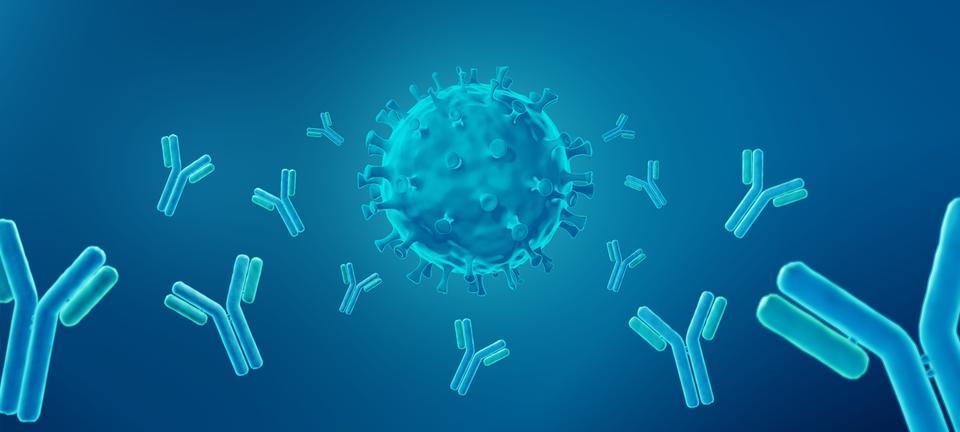You Don’t Learn This in School: My Experience as a NIST Summer Intern

Antibodies are an important part of our bodies’ natural adaptive immune response, but they can also be made into medicine that targets specific parts of the body.
Credit: ART-ur/Shutterstock
The most important thing I remember from being a NIST intern last summer is the power of persistence in research.
When I faced challenges working in the lab, my mentor, Thomas Cleveland, would pause, think about it, and find a new method to try. He had a stoic persistence, regardless of the issues we faced.
I would get a lot more discouraged compared to him!
Credit: NIST
Dr. Cleveland explained that you get used to it. Being more comfortable with not knowing and handling unexpected things makes being persistent easier. The frustration I felt when things didn’t go how I thought they would was an opportunity to grow and learn.
This was one of the important lessons I took away from the NIST Summer Undergraduate Research Fellowship (SURF). I hope to carry his persistent spirit as I continue in my career.
While I’ve learned lots of foundational knowledge from my undergraduate classes, SURF taught me more than any lab class. Although I got hands-on experience in school, lab classes in school don’t have the same element of trying to understand or make something new. They can feel monotonous and lack the feeling of ownership you get from researching something unknown.
At NIST, I was more motivated to learn because I was looking at something not well understood. In school, my lab classes typically illustrated something I’d already learned about. Research at NIST felt more personal because of how long I spent working on the project and the potential impact that research could have. I tried to contribute my own ideas, instead of following a lab manual.
Measuring Antibodies for Medical Research
Our project was aimed at better understanding the structure of the NIST monoclonal antibody reference material (NISTmAb). Antibodies are an important part of our bodies’ natural adaptive immune response, but they can also be made into medicine that targets specific parts of the body. There are more than 100 antibody therapeutics approved, with more being developed. They treat a broad range of medical conditions, such as cancers, autoimmune diseases and COVID-19.
Antibodies are Y-shaped proteins with three different parts, known as domains. The domains are connected by a flexible link, which allows them to take on many different shapes, like arms on your body. For example, one arm can be raised, while the other is lowered. Both can be raised, one can be extended out to the side, or any combination of arm angles can exist.
We use a specialized instrument called an electron microscope — which works with electrons instead of light like a traditional microscope — in this research. We try to measure what proportion of the time the antibody was in a particular shape. This is called conformational distribution. It would be like measuring how often your arms are at your sides, or raised, or resting in front of you on a table, throughout the day.
Scientists don’t understand exactly how an antibody’s conformational distribution relates to its effectiveness, its stability or other properties. A better understanding of this attribute of antibodies could help scientists design better therapeutic drugs. This work fits in with NIST’s mission to provide high-quality measurements to help industry develop innovative biotechnologies. I am glad that I contributed to work that could lead to helping patients get better.
At the end of the summer, it was a challenge to recast my research into a short, accessible form to present to my fellow students. I learned a great deal from all the feedback I got from Dr. Cleveland and other researchers as I practiced my presentation. After incorporating suggestions and lots of practice, I successfully shared my presentation with other students.
How My Internship Influenced My Future Plans
I recently graduated from the University of Maryland with a bachelor’s in biology. I plan on pursuing postgraduate research before going to medical school. This SURF experience opened my eyes to research and built my understanding of this field.
I hope to do clinical or translational research as a physician-researcher later in my career. Translational research is a bridge between basic science and clinical science. One example is the study of mice to research the effectiveness of cancer drugs. I’m pursuing this career path because I want to contribute to advancing medicine in addition to practicing medicine.
Advice for Future Students
I highly recommend SURF to anyone interested in science, engineering or medicine.
The program offers research opportunities in many different areas, but the specifics of your project aren’t as important as learning about the research process itself. Developing a sense of how to ask good questions, focusing on a single problem and getting to know the people I worked with were so valuable to me as a SURF student. Doing research at NIST, in particular, will give you a better understanding of measurement science and the value of proper measurement. That’s important for all empirical research.
What you get from your SURF experience is limited only by how motivated you are to learn and persist.
